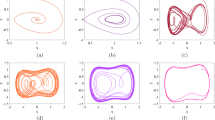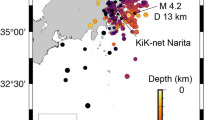Abstract
In marine seismic exploration, the sea surface ghost causes frequency notches and low-frequency loss, which affects the signal-to-noise ratio (SNR) and resolution of seismic records. This paper presents a simultaneous receiver-side deghosting and denoising method based on the sparsity constraint. First, considering the influence of propagation direction and sea surface reflection coefficient, the ghost time delay is calculated accurately, and then the accurate ghost operator is constructed in the frequency—slowness domain. Finally, the ghost-free data are obtained using the sparse constraint algorithm that can effectively suppress the ghost along with the noise energy. This method can remove the ghost and noise simultaneously, achieving quick convergence and with few iterations. It is applied to synthetic data and actual streamer field data. Test results prove that the ghost and notches are suppressed effectively, the SNR is improved, and the band is well broadened.
Similar content being viewed by others
References
Anthony, D., Tilman, K., Walter, S., et al., 2013, Wavefield separation methods for dual-sensor towed-streamer data: Geophysics, 78(2), WA55–WA70.
Beck, A., Teboulle, M., 2009, A fast iterative shrinkage-thresholding algorithm for linear inverse problems: SIAM Journal on Iimaging Sciences, 2(1), 183–202.
Caprioli, P., Özdemir, K., Özbek, A., et al., 2012, Combination of multi-component streamer pressure and vertical particle velocity: theory and application to data: 82nd Ann. Internat. Mtg, Soc. Expl. Geophys., Extended Abstracts, 1–5.
Dushan, B. J., Roger, D. S., Sharon, L. A., 1983, Ghosting and marine signature deconvolution: A prerequisite for detailed seismic interpretation: Geophysics, 48(11), 1468–1485.
Hamarbitan, N. S., and Margrave, G. F., 2001, Spectral analysis of a ghost: Geophysics, 66(4), 1267–1273.
Han, L., 2013, Research on the methods of high-resolution full spectrum decomposition: PhD Thesis, Jilin University.
He, J. W., Lu, W. K., Li, Z. X., 2013, An adaptive over/under data combination method: Applied Geophysics, 10(4), 469–476.
Jewoo, Y., Rob, H., Roald, V. B., 2017, 3D deghosting using echo deblending: Synthetic and field data examples: 87th Ann. Internat. Mtg, Soc. Expl. Geophys., Extended Abstracts, 4945–4949.
Kemal, O., Philippe, C., Ali, O., et al., 2008, Optimized deghosting of over/under towed-streamer data in the presence of noise: The leading Edge, 190–199.
Li, H., Li, G. F., Guo, X. H., et al., 2019, Nonstationary inversion-based directional deconvolution of airgun array signature: Applied Geophysics, 16(1), 116–124.
Li, H. J., Han, L. G., Gong, X. B., et al., 2016, A wavefield prediction and ghost suppression method based on Green Theory: Chinese Journal of Geophysics, 59(3), 1113–1124.
Li, T. S., Gao, H. Q., Liu, Z. X., et al., 1997, The acquisition of ghost information and the study of its generation and frequency response: Geophysical Prospecting for Petroleum, 36(4), 38–44.
Lindsey, J. P., 1960, Elimination of seismic ghost reflections by means of a linear filter: Geophysics, 25(1), 130–140.
Liu, C. C., Tao, J., Jiao, Z. H., et al., 2016, Marine plow streamer acquisition: Oil Geophysical Prospecting, 51(6): 1069–1074.
Per, E. D., Jan, E. L., Vidar, D., et al., 2014, Broadband Broadband Seismic—A Novel Way to Increase Notch Diversity: 84th Ann. Internat. Mtg, Soc. Expl. Geophys., Extended Abstracts, 148–152.
Posthumus, B. J., 1993, Deghosting using a twin streamer configuration: Geophysical Prospecting, 41(3): 267–286.
Shen, H. L., Elboth, T., Tian, G., et al., 2014, Modeling of multi-depth slanted airgun source for deghosting: Applied Geophysics, 11(4), 405–417.
Song, J. G., Gong, Y. L., Li, S., et al., 2015, Highresolution frequency-domain Radon transform and variable-depth streamer data deghosting: Applied Geophysics, 12(4), 564–572.
Soubaras, R., 2010a, Deghosting by joint deconvolution of a migration and a mirror migration: 80th Ann. Internat. Mtg, Soc. Expl. Geophys., Expanded Abstracts: 3406–3410.
Wang, C., Gu, H. M., Xu, Z. Q., et al., 2016, The application of least-squares inversion itration algorithm to deghost for marine variable-depth streamer data: Chinese Journal of Geophysics, 59(5): 1790–1802.
Wang, F. F., Li, J. Y., Chen, X. H., 2013, Deghosting method based on inverse scattering series: Chinese Journal of Geophysics, 56(5), 1628–1636.
Weglein, A. B., Gasparotto, F. A., Carvalho, P. M., et al., 1997, An inverse-scattering series method for attenuating multiples in seismic reflection data: Geophysics, 62(6), 1975–1989.
Weglein, A. B., Shaw, S. A., Matson, K.H., 2002, New approaches to deghosting towed-streamer and ocean-bottom pressure measurements. 72nd Ann. Internat. Mtg, Soc. Expl. Geophys., Extended Abstracts, 1016–1019.
Zhang, X. Y., Pan, D. D., Shi, W. Y., et al., 2015, Deghosting towed streamer data in taop domain based on rough sea surface reflectivity: Applied Geophysics, 12(4), 573–584.
Author information
Authors and Affiliations
Corresponding author
Additional information
This work was supported by the National Natural Science Foundation of China Joint Fund for Enterprise Innovation and Development (No. U19B6003-04)
Li Hong-Jian graduated from Jilin University, obtained a bachelor’s degree in 2011 and a doctor’s degree in 2016. At present, he works in Sinopec Geophysical Research Institute as a senior engineer, engaged in seismic data ghost, multiple suppression, denoising, and improving resolution and other preprocessing technologies. Email: hongjianli22@163.com
Rights and permissions
About this article
Cite this article
Li, HJ., Yang, QY. & Cai, JX. Simultaneous receiver-side deghosting and denoising method based on the sparsity constraint. Appl. Geophys. 17, 411–418 (2020). https://doi.org/10.1007/s11770-020-0829-3
Received:
Revised:
Published:
Issue Date:
DOI: https://doi.org/10.1007/s11770-020-0829-3




